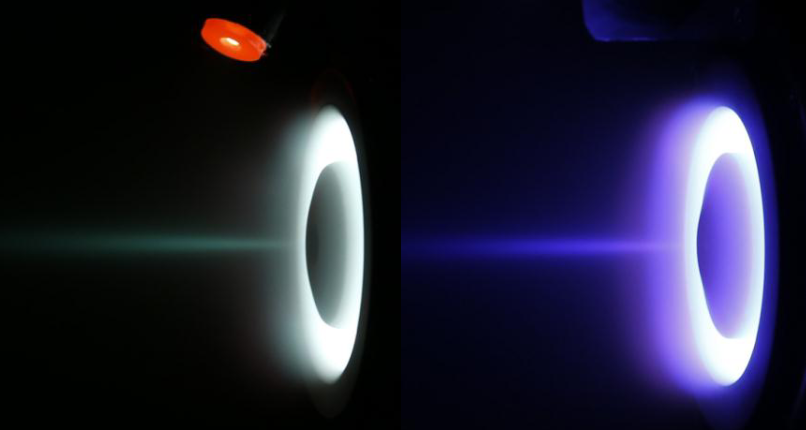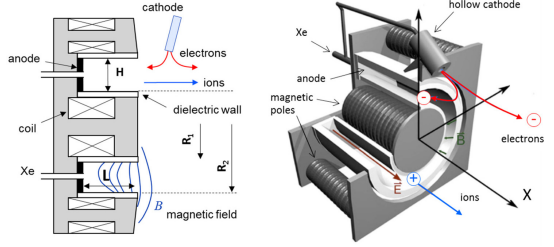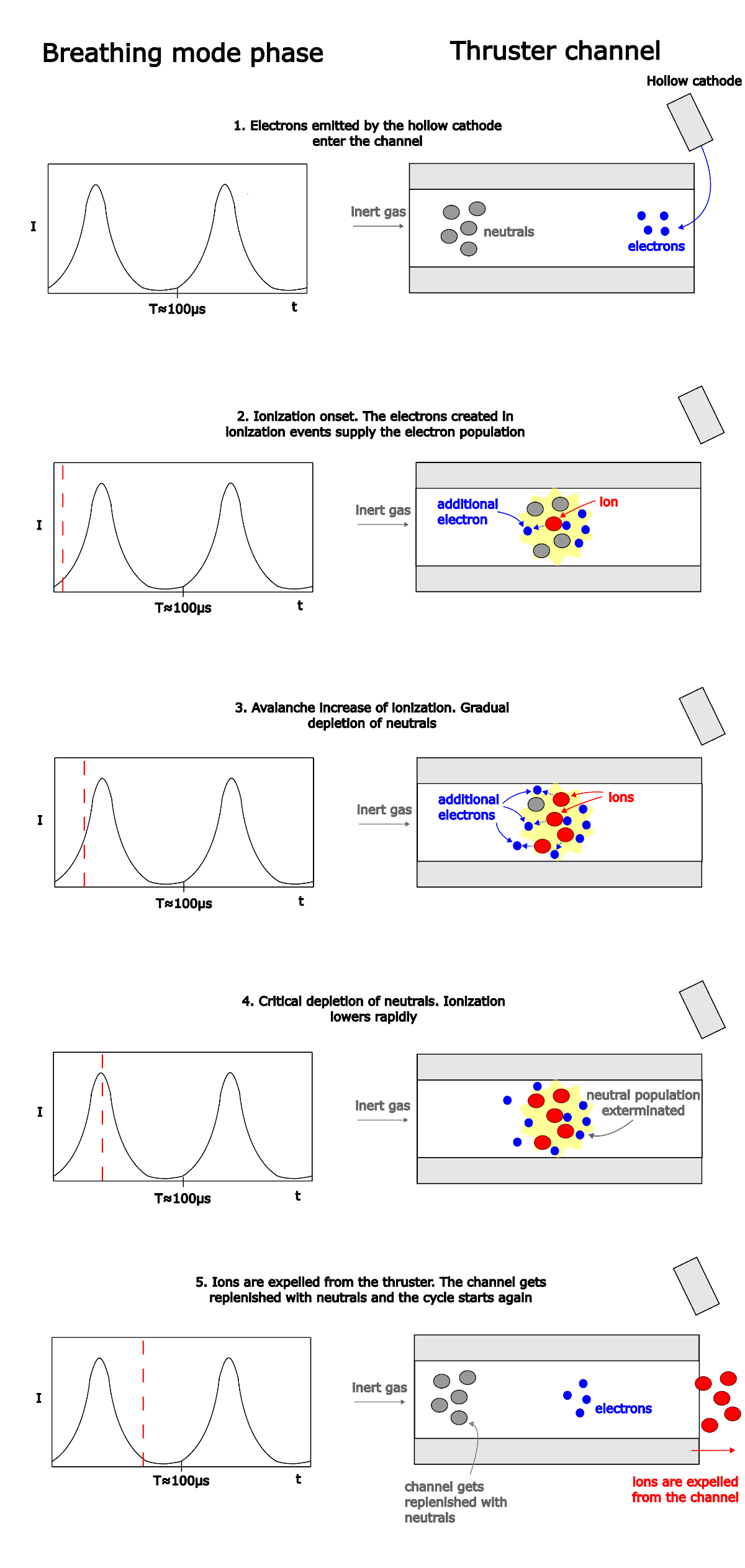
The Hall Thruster
In space, expelling a plume of high speed mass is the only way to propel a spacecraft towards a desired destination. This plume exerts a reaction force on the spacecraft called the thrust force. Thrust acts in the opposite direction to the direction of the plume and causes the spacecraft acceleration. Historically, chemical rocket engines have been the most commonly used devices for thrust production. Chemical rocket engines combust propellants and expel a plume of combustion products through a nozzle.
An alternative to typical rocket engines are Hall thrusters. As against to typical rocket engines, Hall thrusters do not combust chemicals to produce thrust. Instead, thrust is produced by accelerating ionized inert gas in an applied electric field and expelling it from the thruster.
The name Hall thrusters stems from a crossed ExB field, which is applied across the thrusters channel. Inert gas is supplied on one side of the channel. On the other side, an electron emitting device is placed (called hollow cathode). The emitted electrons enter the thrusters channel and are effectively trapped inside the thruster body by the applied radial B field. Inside the body, the electrons eventually collide with an atom of the supplied inert gas, resulting in an ionization event. As a result of the ionization event, the neutral atom is converted to an ion and an additional electron is created. The additional electron supplies the electron population, causing the number of electrons to rise rapidly. Therefore once the ionization is initiated, it rapidly spreads in an avalanche fashion and the thruster is “ignited”.
The created ions are accelerated towards the channel exit by the applied axial electrical field. A plume of high speed ions is formulated at the chambers exit, resulting in the device’s thrust. Figure 1 depicts a typical Hall thruster design.

Hall thrusters have a rich flight heritage. They were first flown by the Soviets in the 1970s and their presence in space has increased ever since[1]. By the early 2000s, more than 100 satellites with Hall thrusters had been flown to space[2]. More recently, Spacex’s Starlink satellites implement Hall thrusters as their choice of propulsion. As of May 2022, approximately 2000 Starlinks are operating on orbit, making Hall thrusters the most popular choice of propulsion technology for satellites.
Ionization oscillations aka the “breathing mode”
The working scheme of a Hall thruster seems pretty straightforward: inert gas flows into the channel where it gets ionized by the trapped electrons. The created ions are expelled from the thruster by the applied electrical field. In reality, plasma creation and flow inside the channel is a complex process, making modelling and simulating the flow an intricate task. Hall thrusters are known to exhibit a large number of plasma oscillations spanning from kHz up to MHz ranges [3,4], which have been observed in both testing and simulation of the devices.
The most prominent of these oscillations is called the breathing mode. This mode has a frequency of the order of 10kHz and leads to large amplitude oscillations of the discharge current. The current oscillations can reach over 100 % of the mean current value, posing the risk of extinguishing the discharge [5].
Despite the risk of becoming unstable and extinguishing the discharge, the breathing mode is known to affect several other aspects of Hall thruster operation. The low frequency oscillations can lead to electromagnetic compatibility issues with the spacecraft, increased erosion of the channel walls, decrease of plume confinement and a resulting decrease of thrust efficiency [6]. These effects negatively influence thruster performance, thus breathing mode suppression is an important engineering challenge in flight Hall thrusters. Nevertheless, recently the possibility of the breathing mode causing an increase thruster performance has been investigated [7]. The full effect of the breathing mode on Hall thruster operation is still an open question and remains a focus of research efforts.
Breathing mode has been observed since the first experimental works in the 1960s. The first theoretical model of these oscillations was derived at MIT by Fife et al. in 1997 [8], and the name “breathing mode” was firstly proposed by J. Boeuf et al. in 1998 [9].
Fife et al compared the breathing mode to a predator-prey interaction between the electrons (predator) and neutrals (prey). The electrons emitted by the hollow cathode are attracted towards the electric field applied across the channel. Once the electrons reach the channel, they start “eating out” the neutrals through ionization. With each ionization event an additional electron is created and an neutral is cancelled. This causes the electron population grow rapidly and so the ionization spreads quickly in an avalanche fashion. At this stage, the creation of additional electrons counterweights the losses of neutrals due to ionization. The avalanche ionization continues until the neutral population gets depleted to an extent at which the electrons have no neutrals to feast on. At this point the high ionization levels cannot be sustained any longer. So the ionization (and so the discharge current) lowers. The lower level of ionization is sustained until the channel gets replenished with neutrals. For typical Hall thruster designs, this usually takes around 100 μs – hence the typical frequency of 10 kHz. Once the channel is replenished, ionization starts to grow and the cycle repeats itself. Figure 2 depicts the cycle of ionization oscillations in a graphical manner.
The predator-prey model provides a clear explanation of physical phenomena causing the breathing mode and replicates the right order of the frequencies observed experimentally. It fails however to predict the amplitude of oscillations and the conditions for instability. Therefore a lot of research effort has been put into modelling of the breathing mode in the last 20 years [10][11][12][13], with none of the proposed model gaining acceptance as the main explanation of the breathing mode. The physics underlying the mode’s onset remains elusive and research in the area continues up to today.

The work of Olgierd Cichorek, one of our PhD students, is focused of developing a new model of the oscillations, with main focus on the conditions causing the onset of the phenomenon. The model will increase the understanding of the breathing mode, allowing scientists and engineers to design improve the performance of the state of art Hall thrusters.
Research on Hall thrusters is being conducted at Institute of Plasma Physics and Laser Microfusion (IPPLM) in Warsaw. Research team led by dr Jacek Kurzyna has carried out two project focused on Hall thruster research and development:
1) KLIMT (years 2013-2016)
2) HIKHET (years 2018-2021)
The title graphic shows the outlet of the KLIMT Hall thruster developed at IPPLM.
References
[1] V. Kim, K. N. Kozubsky, V. M. Murashko et al. „History of the Hall Thrusters Developmnet in USSR”, presented at the 30th International Electric Propulsion Conference, Florence, 2007
[2] P. Sforza “Theory of Aerospace Propulsion” Chapter 13 – Space Propulsion, 2017 pages 669-711
[3] J.-P. Boeuf, “Tutorial: Physics and modeling of Hall thrusters,” J. Appl. Phys. 121, 011101 (2017).
[4] E. Choueiri, “Plasma oscillations in Hall thrusters,” Phys. Plasmas 8, 1411–1426 (2001)
[5] V. Zhurin, J. Kahn, H. Kaufman, K. Kozubsky, and M. Day, “Dynamic characteristics of closed drift thrusters” in 23rd International Electric Propulsion Conference, IEPC-93-095 (Electric Rocket Propulsion Society, 1993)
[6] S. Barral and J. Miedzik „Numerical investigation of closed- loop control for Hall accelerators” J.Appl.Phys. 109, 013302 (2011)
[6] Y.B Esipchuk, A. Morozov, G. Tilinin and A. Trofimov, “Plasma oscillations in closed-drift accelerators with an extended acceleration zone”, Sov. Phys. Tech. 18, 928 (1974)
[7] J. Simmonds, Y. Raitses, A. Smolyakov et al. “Studies of a modulated Hall thruster » Plasma Sources Sci. Technol. 30, 055011, 2021
[8] J. M. Fife, M. Martinez-Sanchez and J. Szabo, Proceeding of the 33rd AIAA Joint Propulsion Conference, Seattle (1997)
[9] J. P. Boeuf, L. Garrigues “Low frequency oscillations in a stationary plasma thruster”, J. Appl. Phys. 84, 3541 (1998)
[10] S. Barral, Z. Peradzyński “A new breath for the breathing mode”, presented at the 31st International Electric Propulsion Conference, Michigan, 2009
[11] S. Barral, Z. Peradzyński “Ionization oscillations in Hall accelerators”, Phys. Plasmas 17, 014505 (2010)
[12] O. Chapurin, A. I. Smolyakov, G. Hagelaar et al. “On the mechanism of ionization oscillations in Hall thrusters”, J. Appl. Phys. 129, 233307 (2021)
[13] T. Lafleur, P. Chabert, A. Bourdon “The origin of the breathing mode in Hall thrusters and its stabilization”, J. Appl. Phys. 130, 053305 (2021)
Feel free to contact ocichorek@cbk.waw.pl if you have any questions about the subject.
